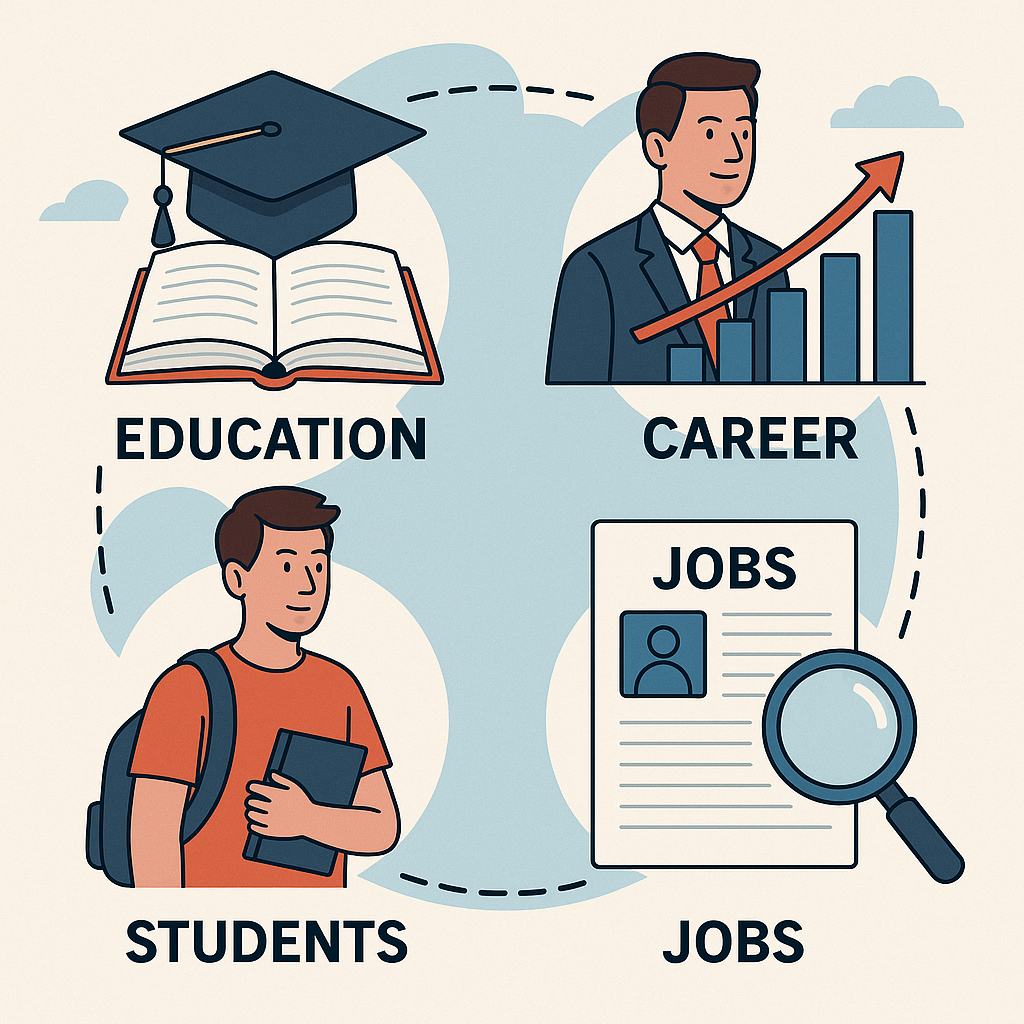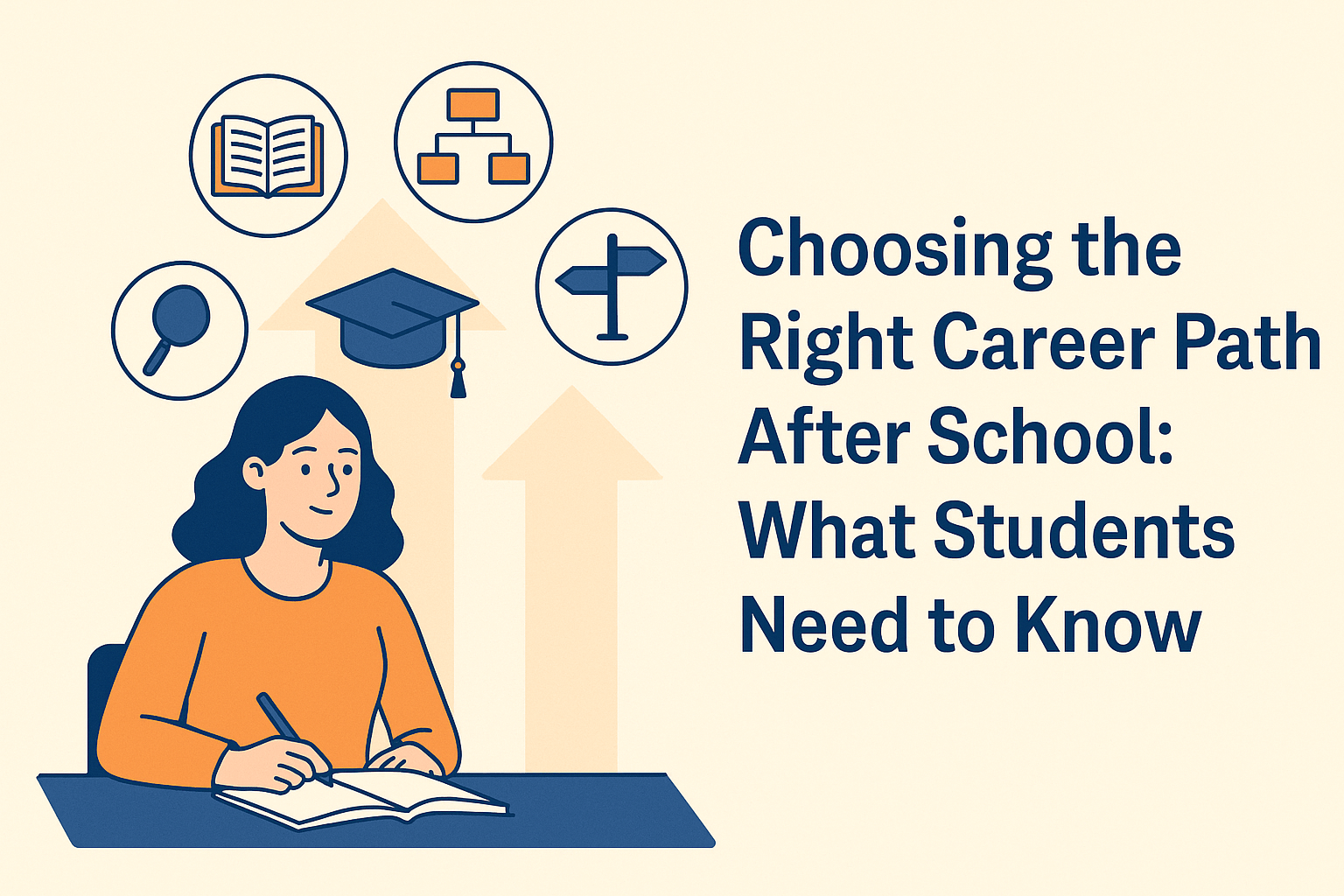In today’s rapidly changing world, the journey from student life to securing a fulfilling career is no longer linear. It’s a dynamic path shaped by shifting job markets, digital disruption, and the evolution of skills. While education remains a critical stepping stone, students now face a broader set of challenges and choices as they prepare to enter a competitive employment environment. With economic uncertainty and automation reshaping work structures, understanding the deeper relationship between learning, job readiness, and professional growth has never been more important.
This article provides a practical view into how education connects with career development, what students need to focus on, and how job seekers can better navigate their way through real-world challenges.
Read:- Highest Paying Jobs in India
The Changing Face of Education
Key Takeaway:
Education is no longer just about acquiring theoretical knowledge; it’s increasingly about equipping learners with adaptable skills that meet today’s work standards and prepare them for future job flexibility and stability.
The traditional education model, which focused heavily on classroom learning and academic theory, has shifted significantly. While degrees and certifications still matter, employers are also looking at soft skills, hands-on experience, and a proactive learning mindset.
Technological growth has introduced new subjects like AI, data science, digital marketing, blockchain, and UX design into academic institutions. At the same time, remote learning platforms have enabled learners in remote or underserved areas to access quality instruction. Students can now pursue diplomas, certificates, or degrees entirely online—sometimes alongside full-time jobs or internships.
Moreover, the emphasis is gradually shifting towards interdisciplinary studies. For example, combining computer science with psychology opens doors in UX design or behavioural AI. These blended educational paths often produce candidates who are better suited to diverse roles in modern industries.
Why Students Must Think Beyond Grades
Key Takeaway:
Grades can open doors, but they don’t guarantee employability. Employers are increasingly valuing problem-solving, communication, adaptability, and collaboration just as much as academic achievements when hiring young professionals.
Many students spend years striving for high scores without realising that employers rarely ask about grades after the first interview. While academic excellence reflects diligence and understanding, it doesn’t always indicate workplace readiness.
Real-world problems are complex, requiring critical thinking and people skills. Internships, volunteer work, student clubs, or freelancing can provide valuable exposure that textbooks often lack. Participating in such activities helps students learn project management, leadership, communication, and how to work in teams—skills that align with what businesses are actively seeking.
This shift highlights the growing importance of experiential learning. Whether through group assignments, case studies, capstone projects, or industry-linked coursework, students benefit significantly from education that mimics real-life tasks.
Vocational vs. Academic Paths: What Should Students Choose?
Key Takeaway:
Both vocational and academic routes offer strong career options. The right choice depends on individual goals, interests, financial situation, and the type of job or industry one wants to work in.
For decades, academic education was considered the superior choice. But this mindset is changing. Vocational education—skills-based and focused on specific industries—is now widely respected and often leads to quicker employment.
Students pursuing trades like plumbing, electrical work, carpentry, beauty therapy, or automotive engineering often start earning earlier than peers who go through lengthy university degrees. Many of these roles offer long-term job security and room for growth, especially as older professionals retire and fewer young people replace them.
Meanwhile, academic paths open doors in professions such as law, medicine, research, and teaching. However, they often involve longer time frames, higher tuition fees, and competitive entrance exams. It’s crucial that students evaluate both options carefully and align them with their personal aspirations.
The Role of Internships and Work Placements
Key Takeaway:
Internships bridge the gap between learning and working. They help students understand real-world job expectations and gain practical experience that makes them more attractive to employers in their chosen field.
Work placements or internships are no longer optional add-ons—they’re often essential. These opportunities allow students to apply what they’ve learned in real-life scenarios, build networks, and understand the nuances of workplace culture.
Companies offering structured internship programmes typically provide mentorship, skill training, and performance feedback. Some internships even convert into full-time roles, which saves both the employer and the candidate from undergoing another recruitment cycle.
Students who include work placements as part of their learning journey often stand out. They come prepared with relevant knowledge, are quicker to adapt, and demonstrate higher levels of initiative.
Career Planning Starts Early
Key Takeaway:
Students who start thinking about their future careers early on are better equipped to make informed educational and professional decisions that align with their strengths, interests, and long-term goals.
Career planning should ideally begin during secondary school. By identifying interests, strengths, and values early, students can make academic and extracurricular choices that bring them closer to their desired profession.
Tools such as personality assessments, skill-building workshops, or career guidance sessions can be helpful in narrowing down fields of interest. Job shadowing or attending career fairs also gives students a feel of different professions before committing to a course of study.
When career planning is proactive rather than reactive, students avoid common pitfalls such as pursuing degrees without clarity, or entering job markets unprepared.
Read more:- Career after MBA in Finance
The Influence of Digital Literacy and Soft Skills
Key Takeaway:
Digital skills and interpersonal abilities have become key hiring criteria. Students who blend technical proficiency with communication, time management, and critical thinking are better suited to succeed in modern job roles.
In nearly every sector—from marketing and finance to healthcare and logistics—digital tools are now deeply embedded in everyday work. Familiarity with platforms like Google Workspace, Excel, Canva, Trello, or coding tools is highly desirable.
But technical skills alone aren’t enough. Employers often rank soft skills as equally important. For example, being able to communicate clearly in a remote team or present ideas effectively in meetings can influence promotions and opportunities.
As automation handles more repetitive tasks, roles involving creativity, empathy, negotiation, and strategic thinking will remain resilient. Thus, a blend of both digital and human skills is essential.
Remote Jobs and the Gig Economy
Key Takeaway:
The rise of freelancing, remote jobs, and gig work has opened new opportunities for students and professionals. It offers flexibility but also demands self-discipline, consistency, and the ability to manage multiple roles.
The job market has seen a major shift in recent years. While traditional employment models still exist, freelancing, short-term contracts, and project-based roles have become increasingly common—particularly among younger workers and students.
Platforms like Upwork, Fiverr, Toptal, and Freelancer enable people to earn from anywhere. For students, this means they can gain work experience or supplement income while still in school.
However, working independently also brings challenges. There’s no fixed salary, benefits, or clear job security. Freelancers must learn to negotiate, manage time effectively, and maintain professional relationships.
This model suits those who prefer flexibility and are comfortable navigating irregular workflows. It’s not for everyone, but it’s growing rapidly and reshaping traditional employment norms.
Lifelong Learning and Career Shifts
Key Takeaway:
Learning doesn’t stop after graduation. Professionals now frequently change roles, sectors, or even careers entirely, making continual skill development and industry awareness vital to long-term career success.
Gone are the days when individuals stayed in one job for their entire career. Today’s workforce often experiences multiple career transitions. Some switch industries, while others start businesses or go back to school for further studies.
This reality makes lifelong learning crucial. Micro-credentials, short online courses, industry certifications, and professional development workshops help individuals remain competitive.
Employers increasingly value candidates who show initiative in learning outside of mandatory training. It signals ambition, resilience, and the ability to adapt to shifting requirements.
Read more:- ANM vs GNM
Job Search Realities for Students and Graduates
Key Takeaway:
The job search process can be demanding. Preparation, patience, and persistence are key—along with having a strong CV, active networking, and understanding how to present one’s skills effectively to recruiters.
Graduates often face stiff competition, even for entry-level roles. That’s why it’s important to start early—build a strong LinkedIn profile, attend industry events, follow recruiters, and seek informational interviews.
Customising cover letters, preparing thoroughly for interviews, and researching employers show a level of seriousness that many applicants overlook. Recruiters notice effort, and thoughtful applicants often stand out even if their experience is limited.
It’s also wise to apply to a mix of roles—some aligned directly with career goals, others that offer indirect experience or a foot in the door.
Preparing for the Jobs of Tomorrow
Key Takeaway:
Future jobs will demand adaptability and ongoing learning. Students who stay curious, practice learning agility, and remain informed about global industry trends will have greater chances of staying relevant and in demand.
With AI, robotics, green energy, and digital transformation influencing all sectors, the jobs of tomorrow may look very different from today’s roles. Some jobs will disappear, while new ones will emerge.
Students should stay aware of shifts in technology, consumer behaviour, and regulatory frameworks. Being able to re-skill and move laterally between industries will become increasingly valuable.
While it’s impossible to predict everything, those who cultivate curiosity, resilience, and strong ethical foundations will be better equipped to face uncertainty.
Conclusion
Education, careers, students, and jobs are all part of a deeply connected cycle. A good education forms the basis for smart career choices. But it doesn’t stop there—students must remain proactive, flexible, and engaged as they transition from classrooms to workplaces.






